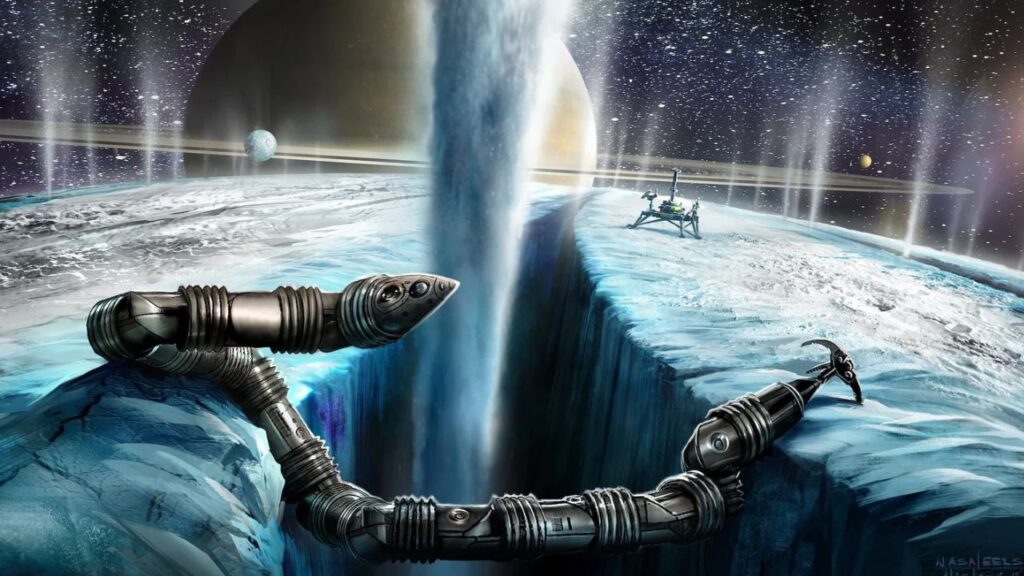As humankind gazes up at the night sky, the icy worlds within our solar system beckon with their mysteries. Among these celestial bodies, Saturn’s moon Enceladus stands out as a particularly intriguing candidate for hosting extraterrestrial life. The answer to whether we are alone in the universe might not come from light-years away but from our cosmic neighbor, and NASA’s innovative Snake Robot could play a pivotal role in this monumental discovery.

The Robotic Pioneer: EELS
The Exobiology Extant Life Surveyor (EELS) is not your typical rover. Conceived and developed by NASA’s Jet Propulsion Laboratory (JPL), EELS represents the next leap in space exploration. Its serpentine form is a masterpiece of engineering, designed to slither through the narrow fissures of Enceladus’ icy surface and delve into the subterranean oceans that lie beneath.
From Earth’s Disasters to Saturn’s Moon
Snake robots are not a novelty on Earth. They’ve been employed in disaster zones, wriggling through debris to locate survivors where humans and traditional robots cannot reach. Their flexibility and resilience have proven invaluable in various industries, including intricate medical procedures. These terrestrial applications have laid the groundwork for their cosmic mission – a mission where they will navigate not through collapsed structures or the human body, but across a landscape alien to any lifeform from Earth.
Enceladus: A Moon with a Secret Ocean
Enceladus has long fascinated scientists. Cassini’s flybys unveiled a world of wonder, where geysers shoot plumes of water ice into the void, suggesting the presence of a vast subsurface ocean. If life exists within our solar system beyond Earth, this moon is a likely home.
The Design and Abilities of EELS
EELS is designed to survive and function in environments that are unforgiving and unpredictable. Its modular design allows it to continue its mission even if parts of its body fail. Equipped with sensors and cameras, it will navigate Enceladus’ labyrinthine ice cracks, drawing a map of a world no human eye has ever seen.
Collaborative Innovation
The project is a synergy of expertise from various institutions. Arizona State University, the University of California, San Diego, and Carnegie Mellon University have joined forces with JPL. CMU’s contribution is particularly noteworthy as they bring years of experience in snake robot development.
Testing and Development
Before EELS can take on the icy shell of Enceladus, it must first prove itself on Earth. Researchers have been rigorously testing its capabilities in glacial environments, simulating the conditions it will face on Enceladus. These tests are crucial, as they allow scientists to refine the robot’s design and functions for its eventual space voyage.
EELS’ Autonomous Operation
Operating millions of miles from Earth, EELS will rely on its autonomous functions. It will be equipped with risk-aware planning, situational awareness, and motion planning to maneuver through Enceladus’ treacherous terrain. This autonomy is essential, as the vast distances make real-time control from Earth impossible.
The Search for Life
The primary mission of EELS is to search for signs of life. It’s not just about finding organisms; it’s about understanding the conditions that could harbor life. By studying Enceladus’ ocean, EELS may uncover the secrets to life’s tenacity, potentially redefining biology as we know it.
The Long Journey Ahead
The journey from concept to Enceladus is a long one. Each step, from design to testing, from launch to landing, is paved with challenges that must be overcome. But the potential rewards are beyond measure. With every turn of its robotic body, EELS could be inching towards answering the age-old question: Are we alone in the universe?
The Legacy of EELS
Beyond its mission, EELS represents the pioneering spirit of humanity. As it traverses the icy plains of Enceladus, it carries our hopes and dreams for discovery. Whether it finds life or not, EELS marks a significant milestone in our cosmic journey – one that stretches our presence beyond the confines of Earth and into the depths of space.
Conclusion
NASA’s snake robot is more than a technological marvel; it is the embodiment of human curiosity. With each segment and sensor, it promises to slither through the unknown, potentially unveiling the greatest discovery of all – life on another world. As EELS readies for its mission, the world waits with bated breath for what it might reveal on the icy moon of Saturn, reminding us that sometimes, the most extraordinary secrets are hidden beneath the surface, waiting for the bold to uncover them.
Read Also-
- SpaceX-NASA Crew 8 Mission: Launching New Horizons to the ISS
- NASA and SpaceX 30th Resupply Mission to ISS: Live Launch and Coverage
- NASA’s Tiny BurstCube Mission: A Giant Leap in Cosmic Exploration
- NASA and Blue Origin& Orbital Reef: Pioneering the Future of Space Habitats










